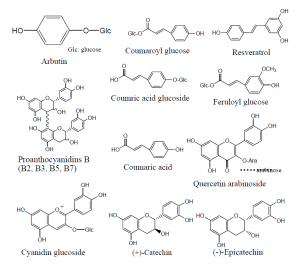
Dietary guidelines worldwide recommend to increase the consumption of fruits and vegetables as they are rich in nutrients and phytochemicals. Small berry fruits are popular because of their attractive color, special taste, and are considered one of the richest sources of natural antioxidants. Among Vaccinium species, Lingonberries are popular in human diet either fresh or processed.
Bioactive Compounds
Lingonberries is a small red berry of Ericaceae family from Nordic countries as well as Scandinavia. The fruit is actually not only rich in functional compounds such as fibers or minerals but also belongs to the family of these “superfruits” rich in antioxidants such as vitamins C, A, and E (tocopherol) and especially polyphenols. Lingonberries have been linked to the prevention of some chronic and degenerative diseases because of the rich content of phenolic compounds and vitamin C. Lingonberries also contain other bioactive substances, such as folate, potassium and soluble fiber.

Figure 1. Bioactive compounds of Lingonberry. (Rihinen K. 2005)
Antioxidant Activity
In the past decade, the antioxidant activity of lingonberry was highlighted through various chemical assays. Most of these evaluations were performed on organic or alcoholic extracts that are not allowed or rarely used in the food industry, and to our knowledge no study was performed on commercial products having been submitted to a complete process. The potential health benefits of lingonberry being brought to the consumers only through commercially available dietary supplements, it appears essential to control the antioxidant activity of the finished products rather than that of the originating berry. The type of extraction as well as the whole food process is thought to deeply affect the polyphenolic composition and thus the efficiency of the resulting lingonberry extract.
Antidiabetic Activities
It is reported that lingonberry has a potent and promising antidiabetic activity in cell-based in vitro bioassays. Mice fed the HFD regimen for a period of 8 weeks establish an obesity-induced prediabetic state. It is at that time-point that low, medium, or high doses of lingonberry (125, 250, 500 mg/kg) were added to HFD and administered over the subsequent 8-week treatment period. The results of this study clearly show that lingonberry possesses an antihyperglycemic effect despite the continued intake of HFD. Indeed, the attenuation of hyperglycemia and dyslipidemia provides evidence of improved insulin resistance in lingonberry -treated DIO groups. These effects were more pronounced as the dose of the plant extract rose from 125 to 250 mg/kg and yet declined thereafter. Such a “bell-shaped” dose-response relationship is not unusual for pharmacological agents, particularly medicinal plants.
Protective Effects against Retinal Photoreceptor Cell Damage
In vitro assays show that lingonberry extracts have protective effects against blue light-emitting diode light-induced retinal photoreceptor cell damage. Blue light is a high-energy or short-wavelength visible light, which induces retinal diseases such as age-related macular degeneration and retinitis pigmentosa. Cultured murine photoreceptor (661 W) cells were exposed to blue LED light following treatment with lingonberry extracts or their constituents (cyanidin, delphinidin, malvidin, trans-resveratrol, and procyanidin B2). Results show that lingonberry extracts and their active components improved the viability of 661 W cells and inhibited the generation of intracellular ROS induced by blue LED light irradiation. These findings suggest that lingonberry extracts containing high amounts of polyphenols exert protective effects against blue LED light-induced retinal photoreceptor cell damage mainly through inhibition of ROS production and activation of pro-apoptotic proteins.
References:
- Rihinen K. Phenolic compounds in berries. Kuopio Univ. Publ. C. Nat. Environ. Sci. 187: 1-97, 2005.
- Paulina Dróżdż, et al. Phytochemical Properties and Antioxidant Activities of Extracts from Wild Blueberries and Lingonberries. Plant Foods for Human Nutrition, 2017, 72(4):360-364.
- Eid HM, et al. Lingonberry (Vaccinium vitis-idaea L.) Exhibits Antidiabetic Activities in a Mouse Model of Diet-Induced Obesity. Evid Based Complement Alternat Med. 2014; 2014:645812.
- Mane C, et al. Food Grade Lingonberry Extract: Polyphenolic Composition and In Vivo Protective Effect against Oxidative Stress. Journal of Agricultural & Food Chemistry, 2011, 59(7):3330.
- Ogawa K, et al. The Protective Effects of Bilberry and Lingonberry Extracts against UV Light-Induced Retinal Photoreceptor Cell Damage in Vitro. Bmc Complementary & Alternative Medicine, 2013, 61(43):10345-10353.

Leave a Reply